
Okazaki Castle is a Japanese castle located in Okazaki, Aichi Prefecture, Japan. At the end of the Edo period, Okazaki Castle was home to the Honda clan, daimyō of Okazaki Domain, but the castle is better known for its association with Tokugawa Ieyasu and the Tokugawa clan. The castle was also known as "Tatsu-jō " (龍城).

Kazusa Province was a province of Japan in the area of modern Chiba Prefecture. The province was located in the middle of the Bōsō Peninsula, whose name takes its first kanji from the name of Awa Province and its second from Kazusa and Shimōsa provinces. Its abbreviated form name was Sōshū (総州) or Nansō (南総). The borders of Kazusa Province were defined by Shimōsa Province to the north, the Pacific Ocean to the east, Awa Province to the south, and Tokyo Bay to the west.

Karatsu Castle is a Japanese castle located in Karatsu, Saga Prefecture, Japan. It is a hirayamajiro, a castle built on a plain rather than a hill or mountain. At the end of the Edo period, Karatsu castle was home to the Ogasawara clan, daimyō of Karatsu Domain. It was also known as "Dancing Crane Castle".

Ōtaki is a town located in Chiba Prefecture, Japan. The town is known for its association with Edo period general Honda Tadakatsu, and its prominent castle. As of 1 January 2019, the town had an estimated population of 8,982 in 3820 households and a population density of 69 persons per km2. The total area of the town is 129.87 square kilometres (50.14 sq mi), making it the largest of Chiba Prefecture's towns and villages.

Isumi District is a district located in Chiba, Japan. As of 2010, the district has an estimated population of 18,593 and a density of 120 persons per km2. The total area was 154.76 square kilometres (59.75 sq mi). The district formerly included all of the city of Katsuura, most of the city of Isumi and a portion of the town of Mutsuzawa. It has been reduced in size through mergers and consolidation to two towns. The district is located in the outer zone of Metropolitan Tokyo, roughly 70 kilometres (43 mi) from the center of the capital.
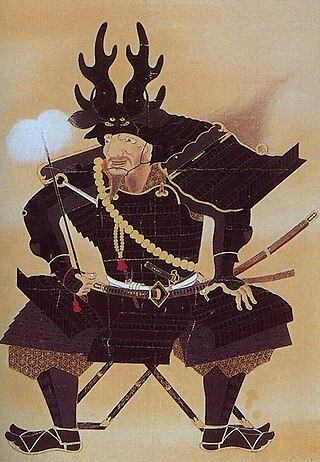
Honda Tadakatsu, also called Honda Heihachirō was a Japanese samurai, general, and daimyo of the late Sengoku through early Edo periods, who served Tokugawa Ieyasu.
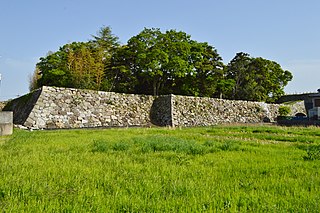
Obama Castle was a seaside-style castle located in what is now the city of Obama, Fukui Prefecture, Japan. During the Edo period, it was the headquarters of a junior branch of the Sakai clan, who were hereditary daimyō of Obama Domain under the Tokugawa shogunate. The castle was also known by the name of Unpin Castle.
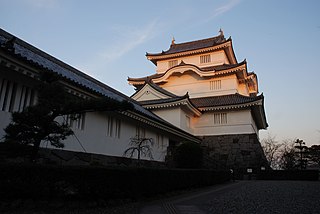
Ōtaki Domain was a feudal domain under the Tokugawa shogunate of the Edo period, located in Kazusa Province, Japan. It was centered on Ōtaki Castle in what is now the town of Ōtaki, Chiba.

The Four Heavenly Kings of the Tokugawa is a Japanese sobriquet describing four highly effective samurai generals who fought on behalf of Tokugawa Ieyasu in Sengoku period. They were famous during their lifetimes as the four most fiercely loyal vassals of the Tokugawa clan in the early Edo period.

Kaminoyama Castle is a hirayama-style Japanese castle located in the center of the city of Kaminoyama, eastern Yamagata Prefecture, Japan. Throughout the Edo period, Kaminoyama Castle was the headquarters for the daimyō of Kaminoyama Domain. The castle was also known as "Tsukoka-jō" (月岡城).
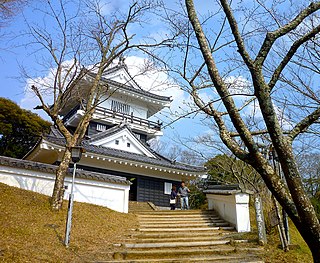
Kururi Castle is a Japanese castle located in Kimitsu, southern Chiba Prefecture, Japan. At the end of the Edo period, Kururi Castle was home to a branch of the Kuroda clan, daimyō of Kururi Domain. The castle was also known as Rain Castle, after a legend that it rained twenty-one times during its construction, or, on average, once every three days. It is located on a 227 meter hill.

Tateyama Castle is a Japanese castle located in Tateyama, southern Chiba Prefecture, Japan. At the end of the Edo period, Tateyama Castle was home to the Inaba clan, daimyō of Tateyama Domain, but the castle is better known for its association with the former rulers of Awa Province, the Satomi clan. The castle was also known as "Nekoya-jō" (根古屋城).

Tateyama Domain was a feudal domain under the Tokugawa shogunate of Edo period Japan, located in Awa Province, Japan. It was centered on Tateyama Castle in what is now the city of Tateyama, Chiba.
Awa-Katsuyama Domain was a feudal domain under the Tokugawa shogunate of Edo period Japan, located in Awa Province, Japan. It was centered in what is now part of the city of Kamogawa, Chiba.

Sanuki Domain was a feudal domain under the Tokugawa shogunate of Edo period Japan, located in Kazusa Province. It was centered on Sanuki Castle in what is now the city of Futtsu, Chiba.
Ichinomiya Domain was a feudal domain under the Tokugawa shogunate of Edo period Japan, located in Kazusa Province, Japan. It was centered on Ichinomiya jin'ya in what is now the town of Ichinomiya, Chiba.
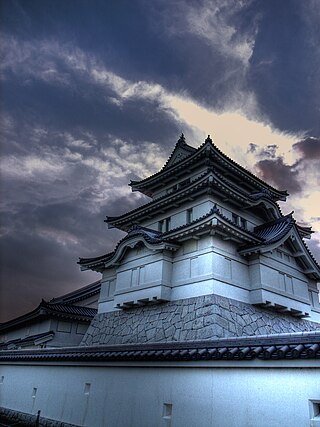
Sekiyado Castle is a Japanese castle located in Noda, northwestern Chiba Prefecture, Japan. At the end of the Edo period, Sekiyado Castle was home to the Kuse clan, daimyō of Sekiyado Domain.
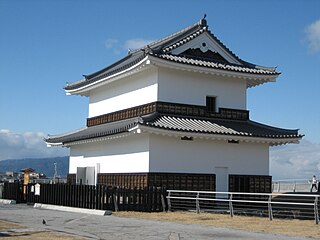
Kuwana Castle is a Japanese castle located in Kuwana, northern Mie Prefecture, Japan. At the end of the Edo period, Kuwana Castle was home to a branch the Matsudaira clan, daimyō of Kuwana Domain. The castle was also known as "Ōgi-jō" (扇城) or "Asahi-jō" (旭城).

Shinjō Castle is a Japanese castle located in Shinjō, northern Yamagata Prefecture, Japan. Throughout most of the Edo period, Shinjō Castle was home to the Tozawa clan, daimyō of Shinjō Domain. The castle was also known as "Numata-jō" (沼田城) or "Unuma-jō" (鵜沼城).
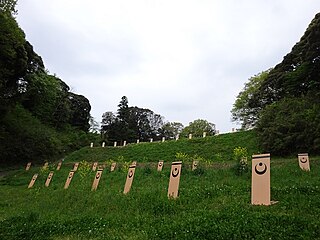
Moto Sakura Castle was a Muromachi period "hirayama"-style castle located on the border of the town of Shisui and the city of Sakura, Chiba Prefecture, Japan. Its ruins been protected as a National Historic Site since 1998.



















